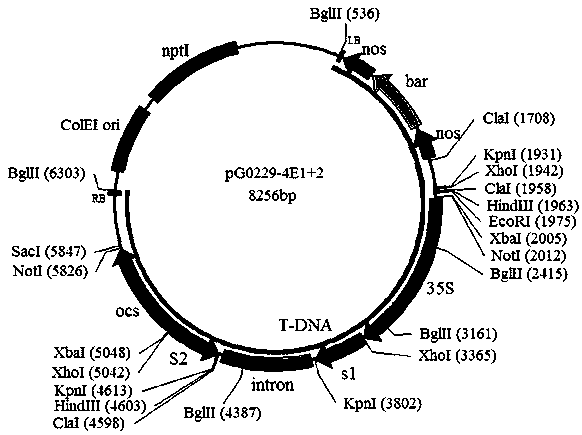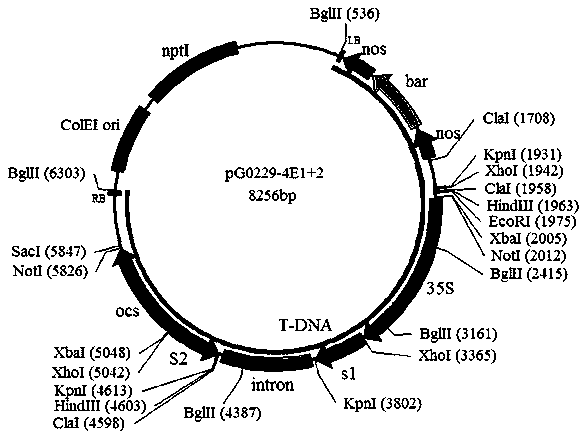Method for cultivating sugarcane resistant to mosaic disease by using RNAi silencing translation initiation factor gene
A technology of translation initiation factor and resistance to mosaic disease, applied in DNA/RNA fragments, genetic engineering, plant genetic improvement, etc., can solve problems such as loss of resistance and insufficient resistance
- Summary
- Abstract
- Description
- Claims
- Application Information
AI Technical Summary
Problems solved by technology
Method used
Image
Examples
Embodiment 1
[0049] Example 1: Cloning of sugarcane translation initiation factor genes SceIF4E1, SceIF4E2, SceIF4E3 genes and verification of their interaction with SCSMV-, SCMV-, SrMV-VPg:
[0050] The SceIF4E1, SceIF4E2 and SceIF4E3 genes of sugarcane were cloned by homologous cloning technique. Using the leaves of sugarcane Badila, a tropical species susceptible to SCSMV, as experimental materials, RNA was extracted by Trizol method and reverse-transcribed into cDNA. Compare the open reading frame (open reading frame, ORF) sequence of eIF4E1, eIF4E2, eIF4E3 gene of sorghum and maize, design three pairs of specific PCR primers, use cDNA as template, and obtain sugarcane SceIF4E1, SceIF4E2 and SceIF4E2 by PCR amplification and RACE. ORF of the SceIF4E3 gene. The nucleotide sequence of the SceIF4E1 gene is the nucleotide sequence shown in SEQ ID NO:1 in the sequence listing, with a full length of 663bp, and its encoded amino acid sequence is the amino acid sequence shown in SEQ ID NO:2 i...
Embodiment 2
[0054] Example 2: Constructing an RNAi interference carrier resistant to sugarcane mosaic disease
[0055] The method for constructing the RNAi interference carrier of anti-sugarcane mosaic disease may further comprise the steps:
[0056] 1. Obtaining the RNAi interference target sequence: using the RNAi vector design library in GenBank to screen the intermediate target segment of the SceIF4E1 gene, and selected the 220th to 436th base segment of the SceIF4E1 gene as the target segment of RNAi, The intermediate target segment of the SceIF4E2 gene was screened, and the 200th to 439th base segment of the SceIF4E2 gene was selected as the target segment of RNAi. A pair of specific primers Sc4E1-F (upstream primer) and Sc4E1-R (downstream primer) are designed for the target segment of the RNAi of the SceIF4E1 gene, and Xba I and Xho I enzyme cleavage sites are introduced into Sc4E1-F, targeting A pair of specific primers Sc4E2-F (upstream primer) and Sc4E2-R (downstream primer) w...
Embodiment 3
[0061] Example 3: Cultivation of a transgenic sugarcane material with broad-spectrum resistance to mosaic disease
[0062] A kind of transgenic sugarcane breeding with broad-spectrum resistance to mosaic disease comprises the following steps:
[0063] 1. Material preparation: extract the constructed RNAi interference vector pG0229-4E1+2 plasmid DNA, measure its concentration and purity with a nucleic acid protein analyzer, and quantify it to 1 μg / μL; the recipient sugarcane variety is ROC22;
[0064] 2. Genetic transformation of sugarcane by bombardment with gene gun:
[0065] The pretreatment of acceptor material: at the top part of sugarcane plant, get the young heart leaf within 10cm above the growth point in the hypertrophy band of white heart leaf, after being sterilized with 75% ethanol with volume concentration, and it is cut into thickness different. Discs larger than 3mm were inoculated on MS+3.0mg / L 2,4-D+30g / L sucrose+6g / L agar powder pH 5.8 induction culture for 7...
PUM
 Login to View More
Login to View More Abstract
Description
Claims
Application Information
 Login to View More
Login to View More - R&D
- Intellectual Property
- Life Sciences
- Materials
- Tech Scout
- Unparalleled Data Quality
- Higher Quality Content
- 60% Fewer Hallucinations
Browse by: Latest US Patents, China's latest patents, Technical Efficacy Thesaurus, Application Domain, Technology Topic, Popular Technical Reports.
© 2025 PatSnap. All rights reserved.Legal|Privacy policy|Modern Slavery Act Transparency Statement|Sitemap|About US| Contact US: help@patsnap.com



